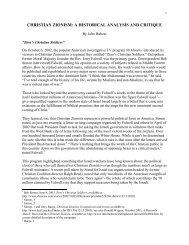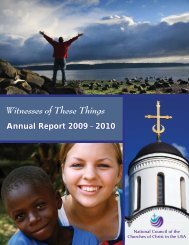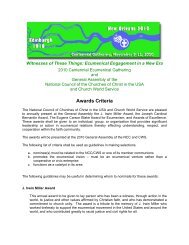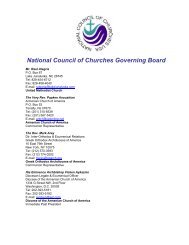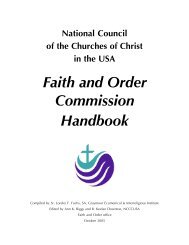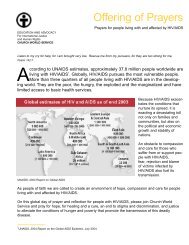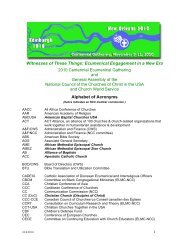Common Agreement on Mutual Recognition of Baptism - National ...
Common Agreement on Mutual Recognition of Baptism - National ...
Common Agreement on Mutual Recognition of Baptism - National ...
Create successful ePaper yourself
Turn your PDF publications into a flip-book with our unique Google optimized e-Paper software.
1060<br />
1061<br />
1062<br />
1063<br />
1064<br />
1065<br />
1066<br />
1067<br />
1068<br />
1069<br />
1070<br />
1071<br />
1072<br />
1073<br />
1074<br />
1075<br />
1076<br />
1077<br />
1078<br />
1079<br />
1080<br />
1081<br />
1082<br />
1083<br />
1084<br />
1085<br />
1086<br />
1087<br />
1088<br />
1089<br />
1090<br />
1091<br />
1092<br />
1093<br />
1094<br />
1095<br />
1096<br />
1097<br />
1098<br />
1099<br />
1100<br />
1101<br />
1102<br />
1103<br />
1104<br />
The scriptural warrant, already present in the 16 th century rites, exemplifies the Reformed<br />
c<strong>on</strong>cern for the centrality <strong>of</strong> the Word in c<strong>on</strong>necti<strong>on</strong> with the sacrament. The stipulati<strong>on</strong> that<br />
baptism is to be d<strong>on</strong>e ―without additi<strong>on</strong>al cerem<strong>on</strong>y‖ echoes the focus <strong>on</strong> water as the primary<br />
symbolic element, signifying both God‘s grace <strong>of</strong> forgiveness and the giving <strong>of</strong> the Holy Spirit.<br />
The adm<strong>on</strong>iti<strong>on</strong> <strong>of</strong> the c<strong>on</strong>gregati<strong>on</strong> signals the ecclesial setting so important to Reformed<br />
baptismal understanding, and the exhortati<strong>on</strong> to parents embodies the link between baptism and<br />
<strong>on</strong>going nurture in the faith. Thus all <strong>of</strong> the major themes that drove the 16 th century reform<br />
c<strong>on</strong>tinued to shape baptismal practice in the Westminster Directory, even though there was a<br />
move away from authorized liturgies and toward increased local freedom in liturgical practice.<br />
In 1788, the newly formed Presbyterian Church in the United States adopted a revised<br />
versi<strong>on</strong> <strong>of</strong> the Westminster Directory for Worship. xiii This versi<strong>on</strong> introduced two changes to the<br />
1645 text. First, the American Directory added a chapter <strong>on</strong> integrating baptized children and<br />
previously unbaptized pers<strong>on</strong>s into the communi<strong>on</strong> <strong>of</strong> the church. This shows new attenti<strong>on</strong> to<br />
the c<strong>on</strong>necti<strong>on</strong> between baptism, catechesis, and the Lord‘s Supper, as well as growing<br />
awareness <strong>of</strong> the possibility <strong>of</strong> adults presenting themselves for baptism. Previously unbaptized<br />
pers<strong>on</strong>s were to be accepted following baptism and public pr<strong>of</strong>essi<strong>on</strong> <strong>of</strong> faith. Sec<strong>on</strong>d, the<br />
American versi<strong>on</strong> removed the detailed descripti<strong>on</strong>s <strong>of</strong> prayers which had been in 1645 versi<strong>on</strong>,<br />
so the descripti<strong>on</strong> <strong>of</strong> the rite (though not necessarily the rite itself) was briefer than in the<br />
original.<br />
On the American fr<strong>on</strong>tier, baptism came to be associated with evangelical c<strong>on</strong>versi<strong>on</strong>,<br />
especially during the sec<strong>on</strong>d Great Awakening. American Reformed churches reacted to this<br />
movement in various ways. Some (like New England C<strong>on</strong>gregati<strong>on</strong>alist Horace Bushnell in his<br />
treatise Christian Nurture) strengthened their defense <strong>of</strong> infant baptism, arguing that faith is best<br />
nurtured in the c<strong>on</strong>text <strong>of</strong> families rather than expecting sudden c<strong>on</strong>versi<strong>on</strong>. Bushnell and others<br />
emphasized the c<strong>on</strong>necti<strong>on</strong> between baptism and <strong>on</strong>going nurture, a theme that had been<br />
prominent in Reformed baptismal practice since the 16 th century. However, with more adults<br />
coming for baptism who had not been baptized as infants, Reformed churches were also<br />
compelled to address the practice <strong>of</strong> adult baptism. This growing interest can be seen in several<br />
19 th century Reformed liturgical publicati<strong>on</strong>s (including Charles Shields‘ 1864 republicati<strong>on</strong> <strong>of</strong><br />
the 1661 Savoy Liturgy ―in agreement with the Directory for Public Worship,‖ xiv the 1868<br />
Directory <strong>of</strong> the United Presbyterian Church <strong>of</strong> North America, xv and the 1894 PCUS Directory<br />
for Worship xvi ).<br />
In additi<strong>on</strong>, the 19 th century saw increased interest in set forms for worship, perhaps in<br />
resp<strong>on</strong>se to freedom <strong>of</strong> the revival traditi<strong>on</strong> and the minimalism <strong>of</strong> the 1788 Presbyterian<br />
Directory. This movement is evident in the introducti<strong>on</strong> <strong>of</strong> set baptismal forms in various<br />
revisi<strong>on</strong>s <strong>of</strong> the Directory for Worship (the 1894 PCUS Directory xvii and the PCUSA<br />
Directory xviii ), and also in the Mercersburg movement in the German Reformed church, a<br />
predecessor traditi<strong>on</strong> <strong>of</strong> the United Church <strong>of</strong> Christ. This movement, centered in the Reformed<br />
seminary at Mercersburg, Pennsylvania, was led particularly by theologian John Williams<strong>on</strong><br />
Nevin. Though it did not have a broad effect <strong>on</strong> German Reformed church practice at the time,<br />
Mercersburg represented a desire to claim a sacramental theology and practice more deeply<br />
informed by both early and Reformati<strong>on</strong> church sources. Furthermore, in the last half <strong>of</strong> the 20 th<br />
century, the Mercersburg movement re-emerged as a significant influence <strong>on</strong> many Reformed<br />
churches in this dialogue seeking to recover a deeper appreciati<strong>on</strong> <strong>of</strong> liturgical forms and <strong>of</strong> the<br />
centrality <strong>of</strong> the sacraments. xix<br />
28



